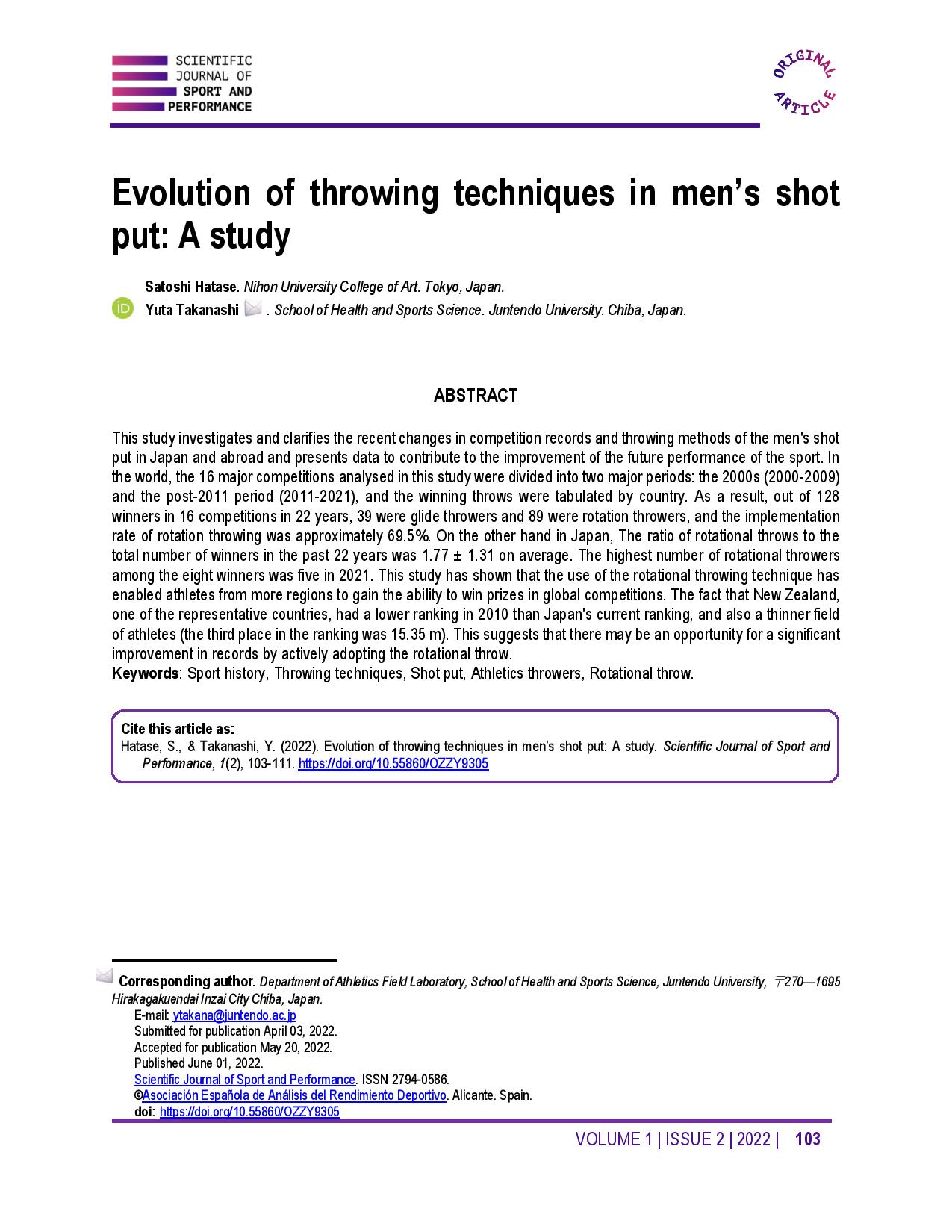Evolution of throwing techniques in men’s shot put A study
Main Article Content
Abstract
This study investigates and clarifies the recent changes in competition records and throwing methods of the men's shot put in Japan and abroad and presents data to contribute to the improvement of the future performance of the sport. In the world, the 16 major competitions analysed in this study were divided into two major periods: the 2000s (2000-2009) and the post-2011 period (2011-2021), and the winning throws were tabulated by country. As a result, out of 128 winners in 16 competitions in 22 years, 39 were glide throwers and 89 were rotation throwers, and the implementation rate of rotation throwing was approximately 69.5%. On the other hand in Japan, The ratio of rotational throws to the total number of winners in the past 22 years was 1.77 ± 1.31 on average. The highest number of rotational throwers among the eight winners was five in 2021. This study has shown that the use of the rotational throwing technique has enabled athletes from more regions to gain the ability to win prizes in global competitions.
Article Details

This work is licensed under a Creative Commons Attribution-NonCommercial-ShareAlike 4.0 International License.
References
Babbitt Don, Reese Hoffa. (2016). A Longitudinal Examination of the Throwing Career of Reese Hoffa.New Studies in Athletics 31, 29-37.
Babbitt Don, Saatara, Mohamad. (2020). Elite level development rates and agebased performance patterns for the men's throwing events: The title of this article says it all: Babbitt and Saatara have crunched the numbers and show at what age male throwers reach peak performance. Track Coach 233, 7428-7432.
Bosen K.O. (1984). A comparison between the conventional and rotational techniques. Track & Field quarterly Review 84, 24.
Byun, O. K., Fuji, H., Murakami, M., Endo, T., Takesako, H., Gomi, K., & Tauchi, K. (2008). A biomechanical analysis of the men’s shot put at the 2007 World Championships in Athletics. New Studies in Athletics, 23, 53–62.
Heger, W. (1974). Is the rotation technique better? Track Technique 58, 1849.
Japan Association of Athletics Federations website (https://www.jaaf.or.jp/)
Lanka, J. (2000). Shot Putting. In: Biomechanics in Sport. V. Zatsiorsky, ed. London: Blackwell Science Ltd., 449.
Maheras, A. (2017). Rotational vs. Glide Revisited. Techniques for Track and Field & Cross Country, 10 (3),19-28.
Monthly Athletics (In Japanese) (Kodansha Co., Ltd. Tokyo Japan).
Pyka, I.,Otrando, B. (1991). Rotational shot put. National Strength and Conditioning Association Journal 13,6-9. https://doi.org/10.1519/0744-0049(1991)013<0006:rsp>2.3.co;2 DOI: https://doi.org/10.1519/0744-0049(1991)013<0006:RSP>2.3.CO;2
Sasaki, D., Sakurada, J., & Wakayama, A. (2017). Movement Comparison about the Throw Technique of Rotational Technique. (Shotput and Discus Throw) Bulletin of Tokyo Women's College of Physical Education. 52, 103-109.
Katoh, T. (2020). Characteristics of kinetic parameter and throwing motion in the rotational shot put technique. Research quarterly for athletics 123, 2-12.
Track and Field Magazine (In Japanese) (Baseball Magazine Co., Ltd. Tokyo Japan.
USA Track & Field (USATF) http://legacy.usatf.org/HallOfFame/TF/showBio.asp?HOFIDs=123
World athletics website (https://worldathletics.org/).
Zatsiorsky, V.M. (1990). The biomechanics of shot putting technique. In: Proceedings of the First International Conference on Techniques in Athletics, Vol. 1 G.P. Brüggemann & J.K. Rühl (Eds) 118-125. Köln: Deutsche Sporthochschule.




